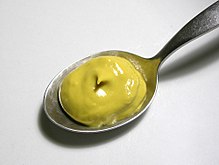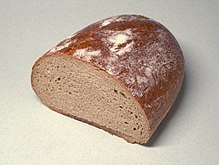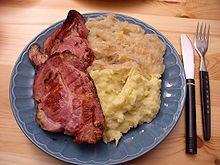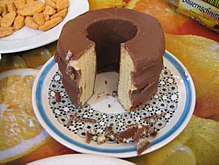German cuisine
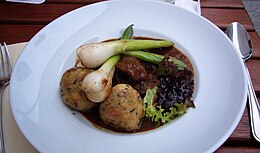
The term German cuisine covers various regional cooking styles and culinary specialties in Germany .
Since the 1950s, everyday cooking , eating and drinking in German households and restaurants has changed significantly and globalized due to influences such as intensely intensified labor migration , mass tourism and increasing industrialization in the production, preservation and distribution of food , or rather by mixing aspects other traditional kitchens. Traditional regional dishes and specialties will continue to be cultivated and developed or rediscovered.
According to the Michelin Guide and other gastro guides , top gastronomy in Germany has achieved a high global status. In the 2015 edition, 282 restaurants nationwide were awarded one or more stars, the third most in the world after Japan and France.
Clichés
German dishes are cliché associated with sauerkraut and hearty, meat-heavy dishes . This is partly explained by the fact that Germany is relatively far north and in the past it was necessary to pay attention to the supply of food energy in harsh winter times . So there are z. B. strong potato dishes . As "typically German" meat supplier is pig viewed. However, this can also apply to the neighboring kitchens, such as Danish , Austrian , Polish , Czech and Slovak cuisine. These criteria reflect a stereotype that can be applied to the larger cultural area of Central Europe. Relatively heavy, high-calorie desserts and cakes such as the Frankfurter Kranz and the Black Forest cake were long considered “typically German”, as were marzipan and Christmas cookies such as gingerbread , pepper nuts , stollen and speculoos .
In the course of globalization and immigration and the stronger networking of German kitchen styles with others from all over the world, the trends are moving towards reduced meat consumption and gourmet cuisine . There is the "rediscovery" of lighter regional dishes, so the earlier clichés about German cuisine are often no longer applicable in a broad sense.
"Clichéd" German dishes: Bratwurst ...
... and pork knuckle on sauerkraut .
Bratwurst with sauerkraut and fried potatoes - stands for German food for foreigners.
German sausage and cheese specialties
Meals
Traditionally, the main meal of the day is lunch, which is eaten between noon and 2 p.m. Dinner is usually a smaller meal that often only consists of a few slices of bread. In recent times, changing work habits have resulted in many Germans eating their main meal in the evening.
The breakfast consists mainly of rolls, toast or bread with jam or honey , sausage or cheese . Also cereal with milk, fruit, yogurt or other dairy products is popular, as is the (hard or soft-boiled) egg . Coffee, tea or juice as well as cocoa or milk are usually drunk.
Food
flesh
The meat consumption in Germany is about 60 kg per year per person; 59% is accounted for by pork , which is often consumed as sausage . Poultry (mainly chicken ) is consumed at 22%, followed by beef and veal at 16%. Other types of meat do not play a role in the kitchen, but are consumed as specialties.
A typical dish is roast pork from the leg and back . These are prepared both fresh and cured , with Kassel pieces being very common. Pork feet are offered both boiled and braised under the regional names Eisbein and Haxe. Minced meat dishes are very common as meat loaf , meatballs and dumplings .
As sausage dishes, German cuisine mainly includes dishes with black pudding and liver sausage , individually or as a combination on the slaughter plate . Leberkäse is widespread in southern Germany both as a snack and as a side dish . The snack dishes also include portioned and heated scalded sausages and raw sausages such as Bockwurst , Frankfurter and Viennese sausages and Knackwurst . Also include bratwurst and currywurst to the kitchen.
Besides veal and roast include beef rolls to the standard dishes. Several types of meat are often combined for goulash . Mixed mince made from beef and pork is also used for minced meat dishes. Boiled and braised beef brisket , like other cooked meat dishes, has lost much of its importance.
Poultry is usually consumed in the form of roast chicken , primarily called broilers in East Germany . Boneless chicken and turkey meat is also used for many dishes such as fricassee . The Christmas goose and St. Martin's goose are common holiday dishes .
A specialty of German cuisine is the consumption of raw, minced meat in various dishes. From pork it is regionally called Mett and Hackepeter , from beef pork meat and tartare , some of which differ in fat content.
fish and seafood
Fish consumption in Germany averages 14 kg per year and per person. Almost two thirds of this is sea fish , a quarter freshwater fish and a good 10% seafood . Alaskan pollock , salmon , herring and tuna are most commonly consumed. Trout , pikeperch and carp are usually offered as farmed fish from local waters . Other species such as eel , perch and pike are only relevant in fishing .
Fish is very often consumed as a canned fish product or smoked fish . Only 5.2 kg are prepared in the kitchen as fresh fish or frozen. Both the fried preparation as Müllerinart (floured and fried) and the blue cooking in acidified cooking liquid are common. Salted herring and young herring are often used as a garnish. Surrogates make up a large proportion ( salmon substitute , German caviar , "trout caviar ").
Specialties are Christmas carp , may plaice and green eel .
vegetables
Vegetables are often eaten in stew dishes and served as a side dish. The vegetables that are by far the most frequently used are potatoes (per capita consumption around 65 kg per year), followed by tomatoes with 10 kg per capita per year and carrots with 7.8 kg per capita per year. Cucumbers and onions are often served in Germany, each weighing around 6.2 kg per head. There are also a number of classic German dishes that use peas , beans and various types of cabbage .
Side dishes
In restaurants in Germany - unlike in Great Britain or Italy - the side dishes are usually included in the total price of a meal.
The most important side dish is the potato . They exist in many variations, such as boiled potatoes , boiled potatoes , dumplings , potato pancakes , fried potatoes , croquettes or mashed potatoes . Large quantities of French fries are eaten as a side dish or as a main course in canteens and fast-food restaurants .
Even rice is, especially fish and poultry as a side dish taken.
German noodles are usually thicker than Italian ones and often contain egg . In the southern part of the country, spaetzle , which contain a very large amount of egg yolk , is mostly used as a side dish.
Spices and condiments
The basis of seasoning in German cuisine is table salt, which is traditionally obtained from brine springs and salt mines . The sweetener is usually sucrose from sugar beet , which is occasionally replaced by honey and sugar beet syrup .
Important local flavor givers are horseradish and table mustard . Depending on the region, must , wine or vinegar is used as an acid in dishes. The most important seasoning vegetable is the onion , which is supplemented with garlic in some recipes . Commonly used herbs are marjoram , thyme , savory and lovage , mostly in dried form, while parsley , chives and dill are used fresh. Caraway and juniper are just as common .
Since the European expansion in the 16th century, spices from Asia, America and southern Africa have been added to the kitchen. The most common are black and white pepper . Spice paprika has been successfully cultivated in more southern parts of Europe and is mainly used as "noble sweet paprika". Frequently used spices are also allspice , nutmeg and clove . From the Mediterranean was laurel , rosemary , basil and oregano over, and this was usually associated with typical dishes from this region.
Dairy products
Germany is one of the countries where dairy products are most diverse. In addition to a wide variety of cheeses , including sour milk cheeses such as Harz cheese , there are many different types of quark , yoghurt , buttermilk and sour milk .
Bread and other baked goods
In Germany there are many kinds of bread, traditionally mainly gray and black bread (u. A. Pumpernickel , rye bread , whole wheat bread , etc.) and predominantly in southern Germany spread pretzels , which also includes the pretzel belongs. UNESCO has listed German bread culture as an intangible cultural heritage since 2014 . However, there are also countless types of white bread on offer. There are numerous variations of cakes and pies, which are mostly baked with fresh apples , plums , strawberries , cherries or rhubarb . Cheesecake is also a popular option. One cake that is considered very typical is the Black Forest cake , consisting of a dark chocolate batter, cherries and cream. Klaben and Stollen are baked during the Christmas season . The Dresdner Christstollen is sold as a specialty throughout Germany. There are also various small baked goods, which are often only known in certain regions.
Desserts
A typical German dessert is the pudding in different variations, e.g. B. as vanilla or chocolate pudding. The red fruit jelly , which consists of different types of berries and is thickened with starch, is popular. Other desserts made from fruit are compote and applesauce. Ice cream has also been popular since ice cream parlors operated by Italians became the first foreign restaurants to spread in the country in the 1920s .
beverages
Beer is popular in all parts of Germany. The per capita consumption in Germany is the third highest in a European comparison with 102 liters. Above all the Pils , but also many regional beers such as Helles , Kölsch , Märzen , Altbier , Weissbier or Berliner Weisse . A mixture of beer and lemonade is called "Radler" or "Spritzes" in the south and "Alsterwasser" in the north.
Wine is popular in Germany and these are known worldwide, a total of 16 wine-growing regions are distinguished. The viticulture in Germany was started by the Romans around the 2nd century on the Mosel. German wine comes mainly from the areas along the Rhine , Danube , Main , Moselle , Neckar , Saale and the upper reaches of the Elbe . Here are Riesling , Müller-Thurgau (Rivaner), Silvaner , Pinot Noir and Dornfelder the famous German grape varieties. The wine is also mixed with carbonated water and drunk as a wine spritzer .
Likewise is cider (also in the southwest Viez called or must) and other fruit wines in the regions of Hesse , Rhineland-Palatinate , Saarland , Baden-Wuerttemberg and other fruit-growing areas again in ascending trend. Its tradition can be traced back as long as that of wine. The consumption of liquor has declined in recent decades, traditionally has been mainly in northern Germany and later in the working class neighborhoods of cities Kornbrand consumed, where in the 19th century with the potato spirit was reached a high point (see. Branntweinpest ). In the past few decades, however, the consumption of mixed drinks such as alcopops and cocktails has increased .
Coffee is also often drunk in Germany, not only for breakfast, but also in the afternoon in the form of coffee and cake . In East Friesland is tea very popular. The most popular non-alcoholic soft drinks are carbonated mineral water , fruit juices, the mixture of both, called “spritzers”, as well as cola and lemonade. A mixture of cola and orange lemonade is called a Spezi . Creations such as iced tea and various mixed drinks are also popular .
Regional cuisine
Southwest Germany
In the extreme southwest of Germany ( Baden , Palatinate , Saarland ) the cuisine is related to that of neighboring Alsace . Tarte and Riesling are as typical as the Dibbelabbes the Saarland. Here are noodles eaten, also called "Bubespitzle" or "Wargenudle" hot. Cherries are made into cherries and the sauerkraut is prepared with white wine. The Palatinate Saumagen , which the former Chancellor Helmut Kohl had served when visiting state guests, is well known. A game dish is saddle of venison Baden-Baden . Roman snails are regarded as a regional specialty ; they are part of the Baden snail soup .
In Saarland cuisine , traditional dishes are, for example, the swivel , spicy pork that is prepared on the grill of the same name ( swivel grill ). The (regional: the) Lyoner is popular as a sausage side dish or with bread . Another popular dish is dibbelabbes , similar to a potato pancake, consisting of grated potatoes and leeks, optionally with or without bacon. Other popular dishes are, for example, Gefillde with bacon and cream sauce and sauerkraut or salad, Married (dumplings and potato sticks ), Hoorische or bean soup.
The Swabian cuisine characterizes the transition from this French-inspired cuisine to Bavarian-Austrian cuisine. Spaetzle go well with numerous dishes such as onion roast, if they are not the main ingredient, as is the case with cheese spaetzle or lentils with spaetzle . Maultaschen and Gaisburger Marsch , like the Swabian sausage salad and "Sulz" and the ox-mouth salad , often eaten with Brägele ( fried potatoes ), are dishes that have their origins in Swabia. Well-known, if not as common as in the past, are offal such as liver and kidneys , tripe and sweetbreads . Freshwater fish, especially Kretzer and whitefish , are valued at Lake Constance .
Bavaria
Due to its cultural and regional proximity, Bavarian cuisine is related to Bohemian and Austrian cuisine .
A wide range of pastries and dumpling dishes such as steamed noodles , yeast , plum , bread and liver dumplings are examples. Typical are the meat dishes such as the Bavarian roast pork with a crust, Reiberknödel (potato dumplings) and coleslaw or the Boeuf ala mode .
Typical of the Bavarian eating habits is the second breakfast, which is traditionally eaten with white sausages , meat loaf or crown meat . White sausage and meat loaf are eaten with sweet mustard and pretzels , grated horseradish and strong bread are served with the crown meat . Often a light or a wheat beer is drunk with it.
Francs
The Franconian cuisine is mainly for their Nuremberg gingerbread and sausages known. A hearty, well-dressed "Grumbernzelod" ( potato salad ) is usually eaten with the sausages . The Franconians also eat bratwurst as a blue tip , they appreciate the Nuremberg Gwärch , the Aischgründer Spiegelkarpfen , Schäufele with potato dumpling and Bamberg onions and, with coffee, Knieküchle or streusel cake . Donuts filled with " Hiffenmark " (rose hip jam) are also popular .
Hesse
Typical of the South Hessian cuisine is what is served in a traditional Frankfurt cider bar. As a companion to the apple wine , the guest can choose between hand cheese marinated in vinegar , served with finely chopped onions and caraway seeds (" Hand cheese with music"), Frankfurt green sauce with jacket potatoes, Frankfurt ribs with sauerkraut and mashed potatoes or Frankfurt beef sausage , which he can eat with a piece of strong bread and mustard or grated horseradish. Bethmännchen are Frankfurt pastries that are eaten during Advent. From Frankfurt to the south is especially in the Odenwald of cooking cheese common, one made of curd cheese. Contrary to its name, it is not cooked. This mild cheese, which runs easily, is generally eaten on or with schnitzel or farmhouse bread.
The North Hessian cuisine has its own specialties. These are, for example, awl sausage , Weckewerk , bacon cakes and duck fat . Green sauce is popular in Northern Hesse, it is made with a different blend of herbs than in Frankfurt.
Rhineland and Bergisches Land
The Rhenish cuisine is characterized on the one hand by the proximity of the francophone part of Belgium , Flanders and the Netherlands and thus the coast and on the other hand by the special features of the Rhineland. The people of Cologne not only bring their old preference for horse meat (the traditional main ingredient of the Rhenish Sauerbratens ) with them, but also the companions to the Kölsch such as the halve Hahn (rye bread with middle-aged Gouda ) and Kölsche Kaviar (blood sausage with onions). Are just as appreciated mussel dishes , the famous Bergische coffee table of the Bergisch Land , Schnippelbohnensuppe , pancakes , potato pancakes and Himmel un Ääd .
Northwest Germany

The north-west of Germany ( Hamburg , Lower Saxony , Bremen , Schleswig-Holstein , Westphalia ) is characterized by its proximity to the sea and the marshland and Geest landscapes . Traditionally, the inhabitants of the towns near the coast, as well as the fishermen themselves, consumed large quantities of fish such as plaice , herring and cod , as well as seafood such as crabs . The Hamburg Pannfisch , once inexpensive leftover food from the port workers, became known nationwide and is now considered typically northern German. Although he (except for a gereichten as a side dish pickled herring ) contains no fish, considered Labskaus than a typical food of the sailors and the North Sea fishermen. A little further inland, the cuisine is essentially based on the local agricultural products, which occasionally include freshwater fish such as pike and eel .
The basics of the main meal are mainly potatoes and cabbage , and in the past also turnips , which in other regions of Germany were often only considered "pig feed". Bread made from rye is characteristic here, as are buckwheat dishes , especially in boggy regions and on the light sandy soils in Holstein or the Lüneburg Heath (e.g. Holstein buckwheat dumplings ). Wheat flour is less used, mostly only in the fertile marshland, for example as Klüten and Dithmarscher flour bags .
Both beef and pork meat , as well as fish, are usually smoked for preservation. Hearty sausages as Bregenwurst and cabbage sausage are typical, and a frequent use of bacon , for example as bacon sauce with fish and boiled cabbage . Known are the kale meals , which are usually served with pee sausage .
Stews , in which salty and hearty ingredients are often combined with the fruity and sweet aroma of fruit and baked fruit , are typical of the region . These include dishes like pears, beans and bacon and hamburger eel soup . Besides are turnips stews as Lübeck National and Snuten un Poten still popular. In summer, lighter fruit and fruit soups with semolina dumplings are preferred, as well as milk soups and fruit pancakes or, for example, pears with dumplings (“Birn 'un' Klütje”).
The traditional dessert is the red grits , which is served with milk or a lightly whipped cream . Well-known pastries from this region are the brown cake , the Copenhagen , butter cake and Franzbrötchen . The Pharisee , a drink made from coffee and rum, comes from this region .
Without the connection to the sea, the cuisine of the Westphalia-Lippe region is quite fish-free, the typical dishes mainly consist of what the agriculture produces. Mention should be made of Pickert , Westphalian ham , Pfefferpotthast , black pudding variations , Hasenpfeffer , Panhas and Pumpernickel . The annual asparagus harvest, to which traditionally melted butter and potatoes are served, should also be mentioned as outstanding.
Northeast Germany
The cuisine in north-east Germany, the Mecklenburg cuisine , Pomeranian cuisine , Brandenburg cuisine and Berlin cuisine is hearty and influenced by neighboring kitchens such as Silesian and East Prussian cuisine . B. Koenigsberger Klopse .
Typical for the Berlin kitchen are pork knuckle , Kasseler , Bockwurst , meatball and currywurst . Dishes from Eastern and Southeastern Europe such as Soljanka or Letscho have been very popular here with the residents since the GDR era. In addition, there are also the traditional fish dishes, especially on the Baltic Sea ( cod ), on the Mecklenburg and Brandenburg inland lakes or in the Spreewald ( pike , pikeperch and trout ).
Potatoes, beets, Spreewald cucumbers and game dishes also play a bigger role. Specifically Brandenburg is famous for cakes and pies (for example, Plinse , pancakes , puffs and clamping cake ). The Sorbian influence is particularly evident in the Spreewald.
Saxony, Saxony-Anhalt and Thuringia
Mainly hearty dishes and beer are known from Saxony , Thuringia and Saxony-Anhalt . Since the 1960s, dishes from Eastern and Southeastern Europe such as Soljanka or Letscho have become popular. Since the Magdeburg Börde , the Leipzig lowland bay , the Thuringian basin and the central Saxon hill country are agriculturally favored areas in terms of soil quality, there is a wide range of vegetables and fruit in the East German cuisine.
- Saxony-Anhalt
is the home of the Halberstadt sausages and various confectionery products such as the Salzwedler Baumkuchen . The areas in the north of the state have (with asparagus and cabbage dishes ) similar regional cuisines to neighboring Lower Saxony and Brandenburg . The Harz is also known for its abundance of game and the Harz cheese . In the south there is transnational viticulture . The northern location allows the production of acidic, tangy varieties such as Pinot Blanc . Germany's largest sparkling wine producer , the Rotkäppchen-Mumm sparkling wine cellars , is at home in Freyburg (Unstrut) .
- Thuringia
"Kitchen neighbors" of the Thuringians are Franconia and Hesse . This is where the Thuringian dumplings and the Thuringian Rostbratwurst , the Mutzbraten and the Rostbrätel come from . Pasta and dumplings are just as popular as potatoes. Minced meat is very popular . Thuringia is known for its innumerable peasant cakes. In the valleys of Saale and Ilm north of Jena, wine is grown across the border to Saxony-Anhalt, with its center in Bad Sulza . Thuringians prefer beer rather than a side drink.
- Saxony
Here, similar to their “kitchen neighbors” in Thuringia, pasta and dumplings or rather Bohemian dumplings are just as popular as potatoes. Saxony is also influenced by Austrian , Bohemian and Silesian cuisine . The Leipziger Allerlei and the Dresdner Stollen , a Christmas biscuit from Dresden , are known beyond the national borders . The cultural proximity to Austria (across the Bohemian border) is reflected in a pronounced love for coffee specialties , fine pastries and the coffee house tradition in general. Saxon regions and cities are known for the Quarkkäulchen , Dresden and Freiberg egg pancakes , Leipzig larks , Meißner fummeln , boiled pork knuckle , Saxon potato soup and the Saxon sauerbraten . The so-called Neunerlei (dialect: Neinerlaa) is one of the Ore Mountains Christmas traditions known around the world . The Elbe wines from Saxony are known, although the Saxons themselves prefer to drink beer.
Traditionally handed down and attributed to Saxony, the spots related to Polish cuisine used to play a role in simple cuisine. Under the influence of the Sorbian population , the dish quark with linseed oil from the “poor kitchen” has gained great popularity in the Ore Mountains and is considered a local specialty.
Silesia
A typical dish from Silesia is the Silesian Kingdom of Heaven , a meat dish with baked fruit . The Silesian corrugated sausage , rustic kettle brawn or pan-fried country liver sausage are among the local sausage specialties. A variety of regional pastries is also offered. Silesian poppy seed cake, Silesian butter crumble cake, Silesian crumble cake and the so-called Liegnitzer bomb are part of the range of some regional bakeries. On Christmas Eve there is Silesian white sausage with sauerkraut and potatoes, poppy seed dumplings for dessert and on Christmas Day goose with red cabbage and Silesian potato dumplings.
See also
- Kitchen of the German Democratic Republic
- German cuisine in the United States
- List of restaurants in German-speaking countries awarded by the Michelin Guide
literature
- Peter Peter: Cultural history of German cuisine . CH Beck-Verlag, Munich 2008, ISBN 978-3-406-57224-1
- German cuisine. 2nd edition, Teubner-Verlag, Munich 2007, ISBN 978-3-8338-0464-9
Web links
Individual evidence
- ↑ 282 restaurants awarded nationwide , Hamburger Abendblatt , November 6, 2014, accessed on January 22, 2015
- ↑ a b BVDF - meat consumption and meat consumption per head of the population. Retrieved June 3, 2020 .
- ↑ Market shares of edible fish in Germany ( Memento of the original from July 5, 2015 in the Internet Archive ) Info: The archive link was inserted automatically and has not yet been checked. Please check the original and archive link according to the instructions and then remove this notice.
- ↑ Market overview, German Farmers' Association, status: 2013/2014. Accessed June 17, 2015.
- ↑ German bread culture. In: Nationwide directory of intangible cultural heritage. German UNESCO Commission, accessed on May 12, 2020 .
- ↑ European Beer Trends. Retrieved June 8, 2020 .
- ↑ apfelwein24.de: What is the difference between must and apple wine?






